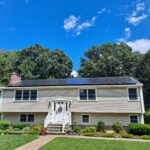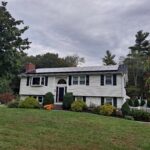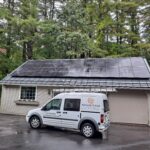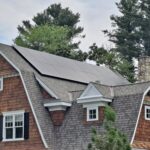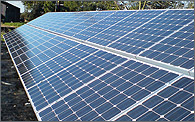 First of all, we think Solarize Massachusetts is a great program that has done a lot to advance solar in the communities that have participated (and in other states that have similar programs). It spreads awareness, increases understanding, and drives down prices for consumers, all of which are keys to any thriving and legitimate industry. The town and state do a lot of hard work to screen Solarize Massachusetts applicants and pick the installers they believe will best serve the interests of the communities. Most of this year’s installers are not local, Massachusetts companies. They are enormous corporations who hire lots of people of varying competence and are not always known for providing the best customer care.
First of all, we think Solarize Massachusetts is a great program that has done a lot to advance solar in the communities that have participated (and in other states that have similar programs). It spreads awareness, increases understanding, and drives down prices for consumers, all of which are keys to any thriving and legitimate industry. The town and state do a lot of hard work to screen Solarize Massachusetts applicants and pick the installers they believe will best serve the interests of the communities. Most of this year’s installers are not local, Massachusetts companies. They are enormous corporations who hire lots of people of varying competence and are not always known for providing the best customer care.
Like any other investment or purchase roughly equivalent to the cost of a new car, it is vitally important to get two or three quotes. Every industry, especially an emerging one like solar, has its share of shysters and goldbrickers. However, the vast majority of the companies working in Massachusetts are staffed by dedicated people doing great work, and three quotes for your potential solar project should be enough to paint a realistic picture for you and weed out the company you wouldn’t want working on your home.
Here are some of the misleading statements overheard at a Solarize community’s “Meet the Installer” meeting. These are actual quotes from representatives of a town’s chosen installer:
“You may get quotes from other solar companies, but other installers may do dishonest things to get people to work with them.”
Hmmm, ok, that’s interesting. I wonder if anything said by this installer will be dishonest or misleading? (Read on!)
With Tier 5 pricing, an example residential PV system has a “3 year payback”.
This really intrigued us, since our best proposals have predicted paybacks in the high 4 or low 5-year range. To see how this works, we backed into their numbers. First, we used the Solarize installer’s base price for an average size system. We know that there will probably not be any installations at this rock bottom price, thanks to the adders, but we wanted to test the limits of their projection. We assumed a system of 25 250-watt panels, for a total DC nameplate rating of 6.25 kilowatts (kW). Next, we assumed utility rates would escalate at 5% annually. Using reasonable assumptions about expected energy harvest from the system and SREC values, we were looking at a 4 year predicted payback. So how did they get to 3 years? In order to hit this fantastic number, we had to assume 100% site efficiency and pie-in-the-sky SREC values.
What is 100% site efficiency? I’ll tell you what it is – unheard of in New England! 100% site efficiency means the roof faces dead south at an ideal tilt and has zero shade 365 days a year from sunrise to sunset. There is no such thing unless you live in a parking lot. Most of the work we have done is on roofs with a site efficiency around 85% or 90%. There are trees everywhere in Massachusetts, and they cast shadows on roofs at some time of the day, even on outstanding sites. So to expect 100% site efficiency is ludicrous. A site with 80% or better site efficiency is still a great investment, but we wanted to point out that we have never seen one that measures 100%.
Even by juicing our production estimate up to simulate a 100% site, we still couldn’t hit 3 years in our model! So the last lever we had to play with was SREC values. In our proposals, we are very conservative with our expectations because the SREC market is subject to the whims of supply and demand and we prefer our customers to be pleasantly surprised when they beat their numbers, rather than be disappointed to be lagging. In our current proposals, we are using a 10-year average SREC value of $0.174/kWh. We had to bump it up to $0.285/kWh in order to hit a 3.3 year predicted breakeven. That’s very optimistic! It could happen, but wouldn’t you rather base your decision on conservative assumptions? I think a solar system with a 5 or 6 year predicted payback is still an outstanding investment. There’s really nothing better you can do with your money.
“Our base panel is 250 watts, and our premium panel is 265 watts.”
There is nothing “premium” about 265 watts. Standard efficiency panels have maxed out at 265 watts since 2011. 265 watt panels represent the best of the mid-range. For years, SunPower has set the gold standard with their high efficiency modules producing 327, 335, and 345 watts. Recently, LG has commercialized panels in the 270-300 watt range. If you want something better than average, it’s LG’s panels. If you want the undisputed best in the world, it’s SunPower. (This particular Solarize installer does not offer either option.)
“High efficiency panels are really just a bunch of marketing hype. They actually send very high voltage to the inverter, which causes it to overheat and produce less power.”
This salesperson revealed his utter lack of comprehension when it comes to basic PV design concepts. It is true that high efficiency panels, such a SunPower, run at a higher voltage – that’s mainly because they’re more efficient and powerful. The truth is all solar designers must adhere to certain rules and constraints when it comes to the voltage making its way down from your roof to the inverter, regardless of what panels are being installed. A good solar designer uses panels in such a way that the inverter is comfortable and works as it should. It doesn’t matter what kind of panels are attached to an inverter, it matters if the system has been designed by experienced solar experts, preferably NABCEP Certified PV Installation Professionals.
Making more power every day, every month, and every year with more powerful panels is the exact opposite of “marketing hype” – it is black-and-while, cold hard numbers.
“You’ll earn more in SRECs in 10 years than you’ll save on your electric bill.”
This is simply untrue. With recent electric rate increases, most customers in Massachusetts are paying the utility company $0.18 or $0.19/kWh for their electricity, and we’ve even seen bills recently above $0.20/kWh. Current SREC values are around $0.24/kWh. We conservatively model an average of $0.174/kWh over 10 years for SREC II participants. Even if we were we to say $0.20/kWh for SRECs, the rate charged by the electric companies would surely eclipse that within a year or two. We expect utility rates in 10 years to be higher than $0.25/kWh.
Over a 30-year lifetime of a solar system, the #1 financial benefit to the homeowner is savings on their electric bills. #2 is the 30% Federal tax credit, and #3 is SREC income. At a distant #4 is the Massachusetts cash rebate and coming in at #5 is the $1,000 Massachusetts tax credit. (Let’s not forget about the environmental benefits either!)
“Once you fill out your contact information, the corporate office in Maryland will contact you.”
Wait, what? You mean you’re not based in Massachusetts? And someone in a cubicle 408 miles away is going to look at a satellite image that may be several years old and tell me if my home is good for solar?
Ethical solar installers with a deep level of expertise do exist. Solar sales people who are so convinced of solar’s environmental and financial viability that they can use conservative projections and a zero-pressure approach also exist. They have integrity, and working with one of these companies delivers full value from their services. Brightstar Solar is one of those installers and we are happy to assist any residential or commercial customer in Eastern or Central Massachusetts. If you are in a Solarize Massachusetts community and want a second opinion, please request a free solar consultation or contact us directly at 617-564-0050.


